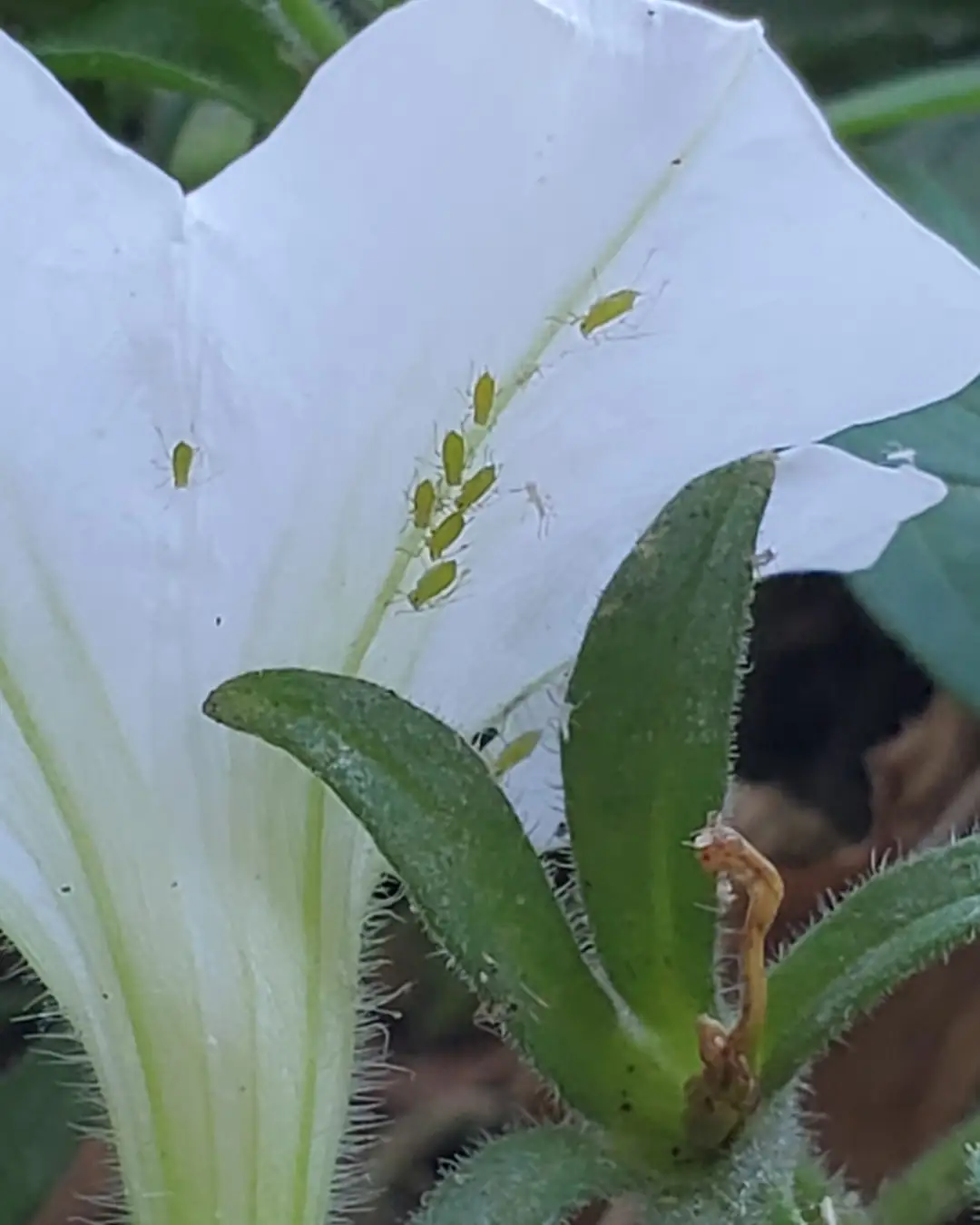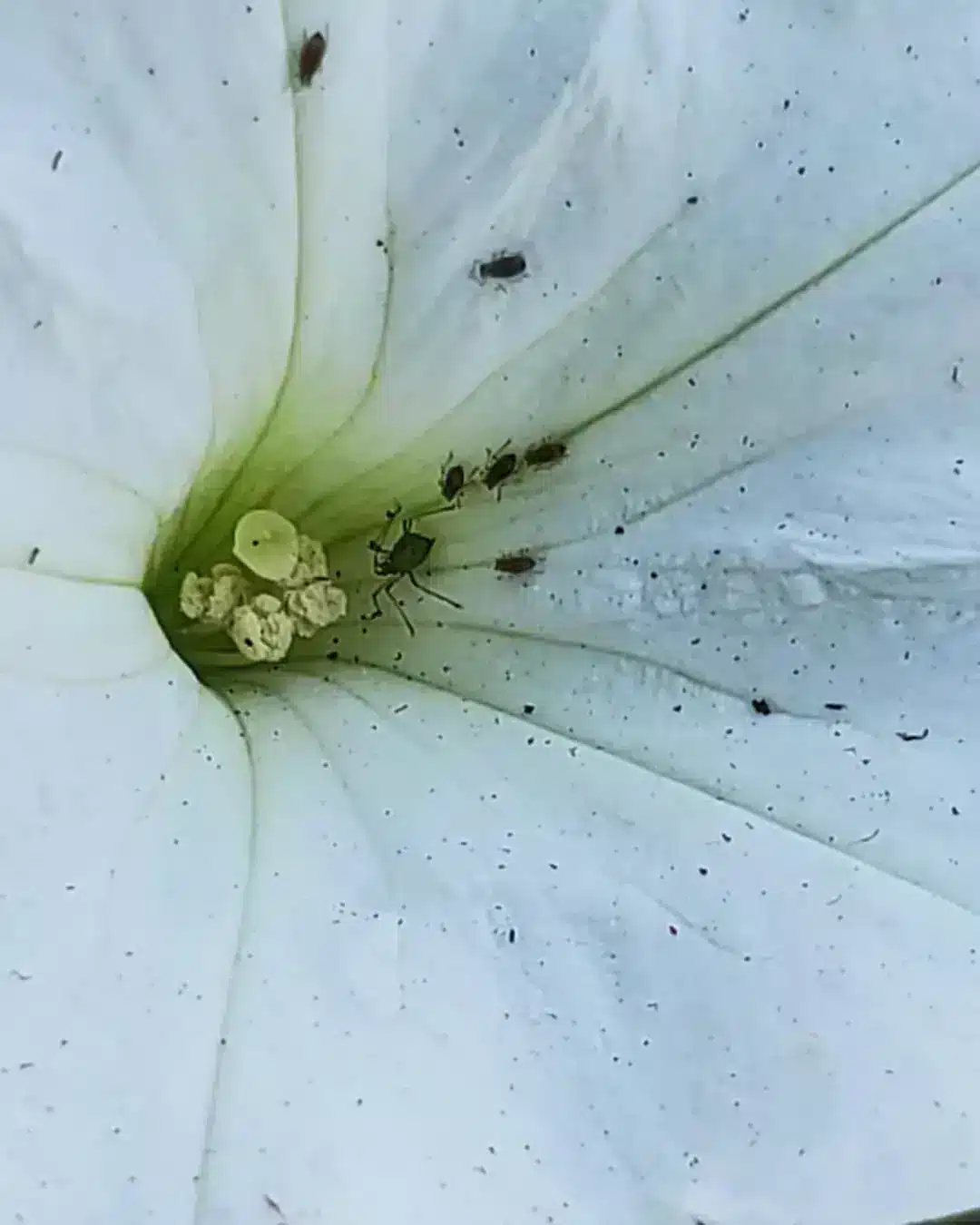How Do I Get Rid of Aphids on Petunias
Petunias are great for adding color to your gardening landscape with their vibrant pink flowers. However, an aphid infestation can cause your petunia plants to struggle, with stunted growth, wilting, leaf discoloration, and sooty mold being some of the common problems.
Aphids suck sap from petunias as they feed, leaving the leaves discolored and distorted with sooty mold. If you have an aphid infestation, apply a strong water spray to dislodge them from your petunias. Alternatively, mix insecticidal soap and water in a ratio of 1:1 and spray it on the aphids to kill them.


Why do my petunias get aphids?
Petunias are naturally prone to aphid infestation. They have a sticky foliage surface that aphids attach to and multiply. Other primary reasons why your petunias get aphids include:
- Over-fertilization: High levels of nitrogen triggers vigorous, nutritious new growth that attracts aphids. Thus, ensure the fertilizer you’re using has the proper nutrient balance. According to the University of Minnesota Extension, the perfect fertilizer balance for Petunias is a ratio of 8-8-8, 10-10-10, or 12-12-12 at a rate of 2 pounds for every 100 square feet.
- Over-watering: In the early stages, overwatering promotes lush and healthy new growth, which attracts aphids.
- Inadequate sunlight: Aphids evade sunlight. That is why they thrive well under the leaves. So, if your petunias have insufficient access to sunlight, they will be prone to aphid infestation.
Signs of aphids on petunias
Here are signs and symptoms that your petunias have an aphid infestation:
Yellowing of leaves
Aphids feed on petunias by sucking on the stem sap, which leads to the yellowing of the leaves. Damage to the stems interferes with the transportation of nutrients and water to the leaves.
Insufficient nutrients, especially nitrogen, cause the yellowing of leaves. Also, aphids multiply at a fast rate, completely covering the leaf’s surface. This limits the degree of light penetration for photosynthesis. Under limited sunlight exposure, petunia leaves start yellowing.
Stunted growth
Aphids feed by sucking plant sap directly from the phloem. This leads to the curling and yellowing of leaves, which distorts the plant’s growth rate.
Also, aphids release a sticky substance, honeydew, which attracts the growth of sooty mold fungus. The fungus reduces the photosynthetic ability of your petunias. With insufficient food, water, and energy, your petunias will grow slower.
Mold fungus
Aphids consume lots of sugars and liquids from the plants that they invade. After digesting what they need, they excrete excess sugars and liquids in the form of a sticky substance known as honeydew.
Honeydew covers the plant’s surface and hardens fast, forming a protective sheath-like layer that’s a favorable habitat for black mold fungus. As the fungi develop on the plants’ surfaces, they shade the leaves, thus diminishing the photosynthetic ability of the petunias.
Black mold fungus causes stunted petunia growth and some of the heavily-coated leaves to die and drop prematurely due to the inability to photosynthesize. Sooty mold is also unsightly and diminishes the ornamental effect of your petunias.
Curling of leaves
The curling of leaves results from insufficient fluids to maintain their rigidity or leaf tips sticking on the sticky excretion – honeydew. The curling of leaves reduces the photosynthetic ability of the host plant, as the surface area of the leaves that are directly exposed to sunlight reduces. As a result, this causes stunted growth.
Gall formation
Aphids are notorious for forming galls in petunias in late spring and summer.[1] Gall formation occurs in late spring during the stimulated growth period of new growth – leaves, stems, and leaves. Aphids damage petunias by feeding on their sap, and their secretions increase the production of normal plant growth hormones.
High production of growth hormones leads to increased cell sizes and numbers. The abnormal cell growth is a disease called leafy gall. Gall takes away important nutrients from the petunias, thus hindering normal plant growth.
How to Get Rid of Aphids on Petunias
Three chemical control products that you can use to get rid of aphids on petunias include insecticidal soap, oil insecticides, and systemic insecticides:
Dish soap
Dish soap is my simplest go-to remedy for aphids on delicate plants like petunias. It coats their bodies and kills them easily.
Simply mix some dish soap with warm water in a spray bottle and give the aphids a good spray. Repeat for a few days, and they should just die off. Wipe or spray off whatever residue is left on the petunias to restore their beauty.
Insecticidal soap
Here’s how to use insecticidal soap to get rid of aphids on petunias:
- Mix ivory liquid soap with warm freshwater in a ratio of 1:1
- Add one cup of oil such as vegetable, soybean, or peanut oil.
- Put the mixture in a sprayer and spray your petunias early in the morning or evening to maximize effectiveness.
- Spray the affected petunias thoroughly but not to the point of runoff.
- Repeat the application weekly to kill all the aphids.
The approach of using insecticidal soap is beneficial when it comes to managing aphids on petunias. Insecticidal soap controls aphids and washes away fungus without adverse effects on your petunias, beneficial insects, and the environment.
Insecticidal soap contains fatty acids that destroy the structure of the insects’ cell membranes. The cell contents leak from the damaged cells, killing the aphids quickly.
Oil insecticides
Oil insecticides, either neem or horticultural oil, are very useful for getting rid of aphids. Here is the procedure for using oil insecticides on aphids:
- Mix 2 to 5 tablespoons of either neem or horticultural oil with 1 gallon of water (regular watering can).
- Spray the topside and underside of the petunia leaves.
- Repeat the spraying weekly until your petunias are free of aphids.
Systemic insecticides
This is not the best treatment approach for your petunias as it kills even the beneficial insects which aid in controlling aphids. Nevertheless, in case of a heavy aphid infestation, the use of systemic insecticides is the most appropriate method. Here is the procedure for using systemic insecticides:
- Add systemic insecticides that contain either azadirachtin or pyrethrin in a spraying can.
- Spray your petunias thoroughly.
- Spraying petunias with insecticides kills even the beneficial insects. So, after spraying, purchase a new batch of beneficial insects for your garden.
Biological control
Using beneficial insects (natural enemies) is an effective biological method of getting rid of aphids. Beneficial insects such as parasitic wasps, lady beetle, syrphid flies, and lacewings are very effective in controlling aphids.
The predators feed on the aphids suppressing their numbers from the start. Parasitic wasps parasitize aphids by laying their eggs inside them. The parasitized aphid’s skins turn crusty and golden brown, a form known as a mummy. After the formation of mummies, the aphids are likely to reduce significantly within 7-14 days.
Mechanical control
Mechanical control is another effective way of controlling aphids. There are two ways to eliminate aphids mechanically:
- Rinse them off the leaves of the host plants: Use a water hose and nozzle with enough pressure to knock them off the plant’s foliage but not damage the plant. After washing them off the plant, aphids cannot climb back to the plant, and as a result, they will starve to death. This is effective for a large population of aphids.
- Rubbing aphids off the plant using your fingers or a wet cloth: This approach is practical for a small population of aphids and at the early stages of infestation.
Prevention
- Using eggshells: The edges of crushed eggshells make several cuts on the aphid’s body, dehydrating them and eventually causing death.
- Avoid over-fertilization: High nitrogen levels promote succulent, nutritious new growth, attracting aphids. Use small amounts of fertilizers throughout the growing season to reduce the chances of an aphid outbreak.
- Use a reflective silver mulch: Aphids hide beneath petunias foliage to evade predators and sunlight. Using silver mulch increases the amount of solar energy reflected onto the leaves. This scares off aphids.
- Companion planting: Some plants repel aphids, such as catnip and nasturtiums. So, interplant them with your petunias to keep away aphids.
- Avoid overwatering: Overwatering promotes healthy and soft new growth, which attracts aphids. So, give your petunias just enough water to thrive.
- Plant your petunias in full sun: Aphids thrive well in the absence of enough sunlight. So, to prevent your petunias from aphid infestation, plant them in full sun.
Conclusion
Aphids can cause leaf yellowing, wilting, stunted growth, and black mold infestation. To successfully get rid of aphids on petunias, consider chemical control using insecticides, biological control using beneficial insects, and mechanical control. Also, prevention measures such as using silver-like mulch and companion plantings aid in keeping aphids at bay.
The effectiveness of the methods depends on the aphid’s population and how widespread the infestation is.
References
- [1]Schultz, J.C., Edger, P.P., Body, M.J.A. et al. A galling insect activates plant reproductive programs during gall development. Sci Rep 9, 1833 (2019). https://doi.org/10.1038/s41598-018-38475-6

